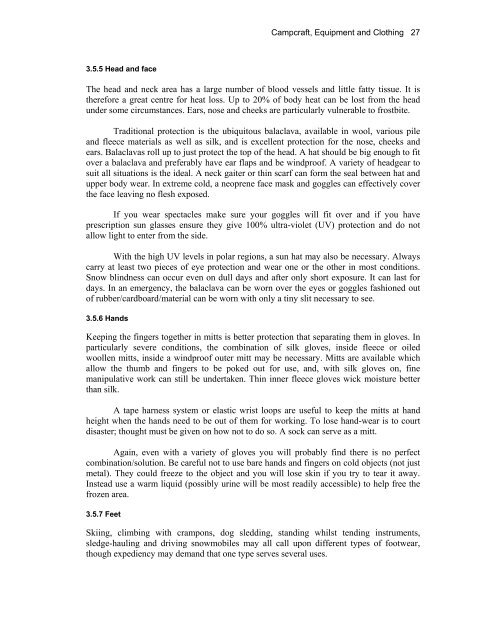Edited by Rachel Duncan 4th Edition ISBN 0-907649-91-2 London ...
Edited by Rachel Duncan 4th Edition ISBN 0-907649-91-2 London ...
Edited by Rachel Duncan 4th Edition ISBN 0-907649-91-2 London ...
You also want an ePaper? Increase the reach of your titles
YUMPU automatically turns print PDFs into web optimized ePapers that Google loves.
3.5.5 Head and face<br />
Campcraft, Equipment and Clothing 27<br />
The head and neck area has a large number of blood vessels and little fatty tissue. It is<br />
therefore a great centre for heat loss. Up to 20% of body heat can be lost from the head<br />
under some circumstances. Ears, nose and cheeks are particularly vulnerable to frostbite.<br />
Traditional protection is the ubiquitous balaclava, available in wool, various pile<br />
and fleece materials as well as silk, and is excellent protection for the nose, cheeks and<br />
ears. Balaclavas roll up to just protect the top of the head. A hat should be big enough to fit<br />
over a balaclava and preferably have ear flaps and be windproof. A variety of headgear to<br />
suit all situations is the ideal. A neck gaiter or thin scarf can form the seal between hat and<br />
upper body wear. In extreme cold, a neoprene face mask and goggles can effectively cover<br />
the face leaving no flesh exposed.<br />
If you wear spectacles make sure your goggles will fit over and if you have<br />
prescription sun glasses ensure they give 100% ultra-violet (UV) protection and do not<br />
allow light to enter from the side.<br />
With the high UV levels in polar regions, a sun hat may also be necessary. Always<br />
carry at least two pieces of eye protection and wear one or the other in most conditions.<br />
Snow blindness can occur even on dull days and after only short exposure. It can last for<br />
days. In an emergency, the balaclava can be worn over the eyes or goggles fashioned out<br />
of rubber/cardboard/material can be worn with only a tiny slit necessary to see.<br />
3.5.6 Hands<br />
Keeping the fingers together in mitts is better protection that separating them in gloves. In<br />
particularly severe conditions, the combination of silk gloves, inside fleece or oiled<br />
woollen mitts, inside a windproof outer mitt may be necessary. Mitts are available which<br />
allow the thumb and fingers to be poked out for use, and, with silk gloves on, fine<br />
manipulative work can still be undertaken. Thin inner fleece gloves wick moisture better<br />
than silk.<br />
A tape harness system or elastic wrist loops are useful to keep the mitts at hand<br />
height when the hands need to be out of them for working. To lose hand-wear is to court<br />
disaster; thought must be given on how not to do so. A sock can serve as a mitt.<br />
Again, even with a variety of gloves you will probably find there is no perfect<br />
combination/solution. Be careful not to use bare hands and fingers on cold objects (not just<br />
metal). They could freeze to the object and you will lose skin if you try to tear it away.<br />
Instead use a warm liquid (possibly urine will be most readily accessible) to help free the<br />
frozen area.<br />
3.5.7 Feet<br />
Skiing, climbing with crampons, dog sledding, standing whilst tending instruments,<br />
sledge-hauling and driving snowmobiles may all call upon different types of footwear,<br />
though expediency may demand that one type serves several uses.

















